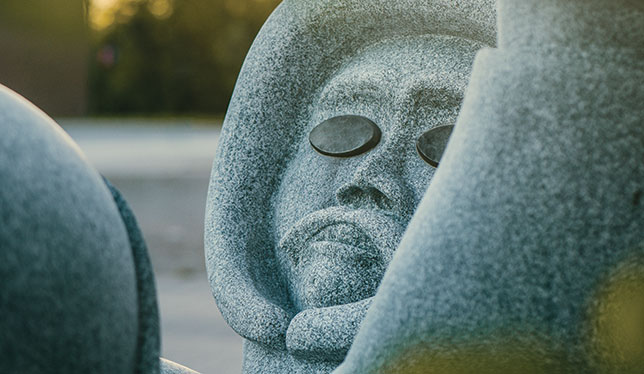When the Truth and Reconciliation Commission released its 94 calls to action in 2015, several of them referenced institutions of higher education. In response, there have been changes to curriculums, more Indigenous-focused administrative and faculty positions have been created, and the number of scholarships and bursaries for Indigenous students has increased.
Many universities also started to commission and unveil new Indigenous artworks in a wide range of mediums. While we don’t have the space to highlight the vast array of striking pieces found on Canadian campuses, what follows is a selection of 11 works that highlight the diversity of styles Indigenous artists employ, and the powerful messages their work often conveys.
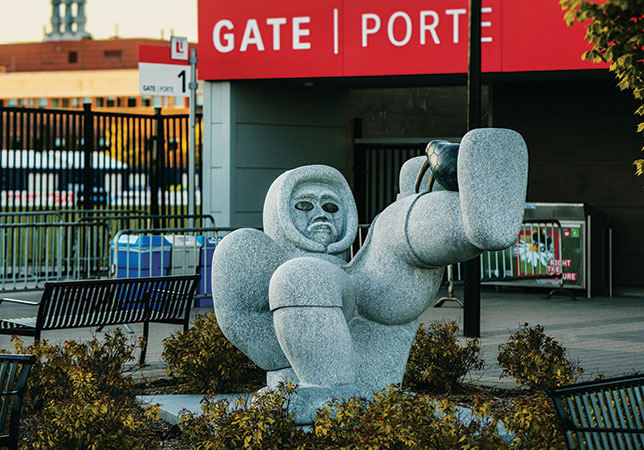
Year of installation: 2016
Institution: York University
Artists: Ruben Komangapik and Koomuatuk Curley
A 26-tonne granite sculpture by two Nunavut artists rests at the entrance of York University’s Lions Stadium, welcoming spectators with an expression of Inuit mythology. The piece, which was unveiled in 2016, depicts a young Inuk soccer player in an Alaskan high-kick position with a walrus skull.
Ruben Komangapik and Koomuatuk Curley assembled a team of students and young artists to help them carve the granite using traditional sculpting techniques, which eschew calibration tools or lines drawn onto the rock. The artists hope the piece will inspire Inuit students to persevere through their studies and bring attention to Inuit traditions. “This is a great example for Inuit people that we can accomplish anything if we are determined,” Mr. Curley said at the unveiling ceremony.
In Inuit mythology, the aurora borealis represents the souls of the dead. Mr. Komangapik, who was featured in a short documentary on soccer in the Arctic in 2019, said that in his culture “when the lights dance across the sky, it is the spirits playing soccer with a walrus skull.” In Inuktitut, the word for aurora is “ᐊᖅᓴᕐᓂᖅ,” or “askarniq,” which translates to “ball player” in English.
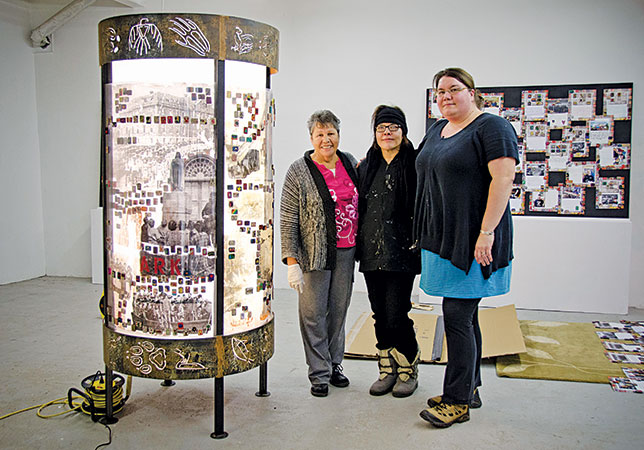
Year of installation: 2014
Institution: Algoma University
Artist: Shirley Horn (pictured on the left)
At the tender age of five, Shirley Horn was taken from her family and sent to a residential school to learn the “white man’s ways,” as she describes it. Ms. Horn was severed from her language, culture, land, and community – along with an estimated 150,000 other Indigenous children – as part of the federal government’s decades-long assimilation policy. Two years after she was taken, Ms. Horn was transferred to the Shingwauk Indian Residential School, the site of what is now Algoma University. She went on to study at Algoma, graduating with a bachelor of fine arts and later becoming the university’s first chancellor.
An accomplished artist and advocate, Ms. Horn and two colleagues applied their talents to honour the former students at the Sault Ste. Marie, Ont., residential school through an installation that now stands in one of Algoma’s main buildings. Titled “Children to Children,” the rusted steel and plexiglass structure is adorned with documentary evidence and artistic renditions of the lived experiences of Indigenous children. Each of the four panels signifies a generational evolution to the present day: from living in peace, to the harm of assimilation, organizing to heal from injustices, and finally establishing the foundation for a hopeful future. Each panel features hundreds of tiles painted by Ontario students that communicate their understanding of the residential school system. “We’ve come all this long way so that this generation can have a better future,” says Ms. Horn.
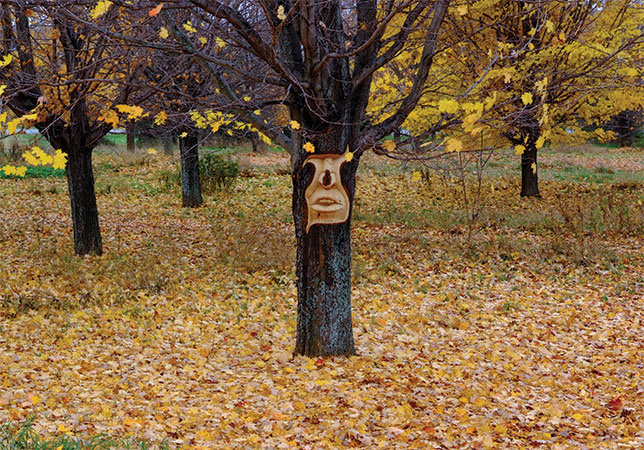
Year of installation: 2012
Institution: Université de Moncton
Artists: Edward “Ned” Bear
Since 2012, a tree at the Parc écologique du Millénaire near Université de Moncton’s Pavillon Pierre-Amand-Landry has featured a large mask carved directly into the trunk by artist Edward “Ned” Bear. “Pawakan,” created by the Wolastoqiyik and Plains Cree artist for the Art Nature Symposium in Moncton, is meant to be the incarnation of a “spirit guide, an incorporeal being from Indigenous folklore that guides people with the help of spiritual journeys into hidden worlds sometimes seen through visions, dreams or near-death experiences.”
In fact, Mr. Bear’s hand-carved masks, marble and limestone sculptures are contemporary interpretations of Indigenous spiritual traditions. He has garnered international recognition and was notably a teacher and researcher at the Smithsonian Institution in New York City, in 2006.
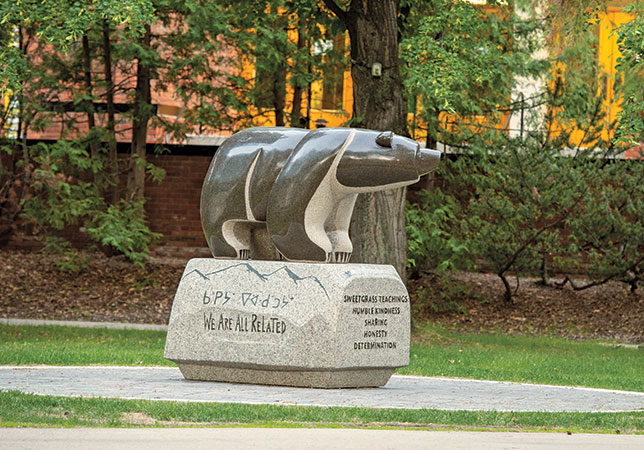
Year of installation: 2016
Institution: University of Alberta
Artist: Stewart Steinhauer
For the past six years, a granite bear sculpture has stood in the quad on the University of Alberta’s North Campus. Carved by Indigenous stone sculptor Stewart Steinhauer, it was the first of four instalments at the U of A signifying the institution’s commitment to reconciliation. “The Sweetgrass Bear reminds us that we are all treaty people,” then-president David Turpin said at the unveiling. “She is a symbol of our relationships. On her side is an inscription that reads, ‘We are all related.’”
The sculpture weighs over six tonnes and took two summers for Mr. Steinhauer to complete. “I work outside, using a very different method than most other carvers, called the ‘attack method.’” Since I don’t start with drawings or miniatures, I am able to finish projects fairly quickly,” he says, adding that he uses intuition and emotion to determine when a piece is complete.
Engraved on the front of the sculpture are the four “sweetgrass laws”: humble kindness, sharing, honesty, and strength. “These teachings are significant in Treaty 6 territory, where I am located,” Mr. Steinhauer explains.
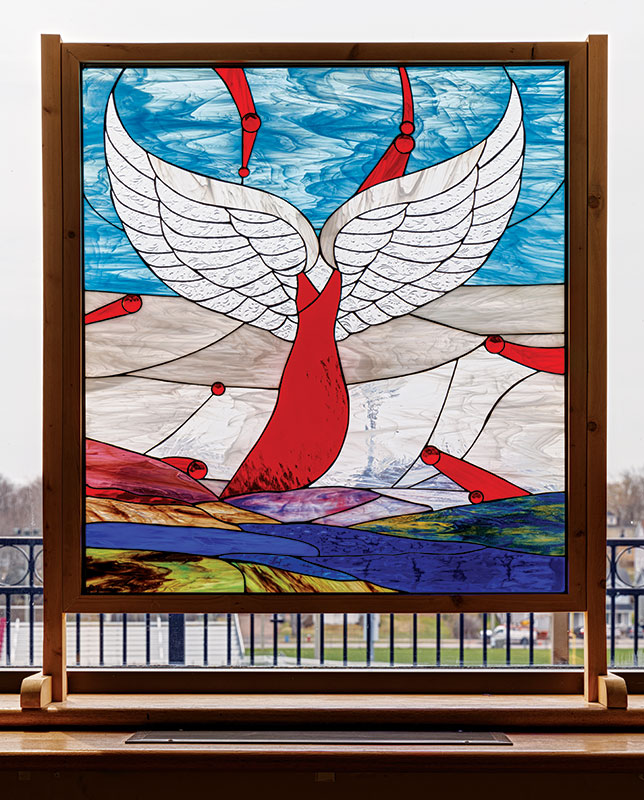
Year of installation: 2019
Institution: Mount Allison University
Artist: Pauline Young
The red dress has become a powerful symbol for missing and murdered Indigenous women and girls in Canada. Universities will often hang red dresses from trees or fences on May 5, which the federal government has declared a national day of awareness. The red dress was the symbol of choice for Mi’kmaq artist Pauline Young when she was commissioned by Mount Allison University to create an installation for their student centre. “She Lights the Way” is meant to commemorate the many lives lost to violence, but also to inspire hope and healing.
“It is my dream that one day, every person will know what the symbol of the red dress means and someday, every person will realize that we are in a crisis with missing and murdered Indigenous women and girls across Turtle Island,” said Patty Musgrave-Quinn, Mount Allison’s Indigenous affairs co-ordinator, at the unveiling. “I hope that one day, people will be sitting at dinner talking about it, joining the Facebook pages on MMIWG and sharing the pictures, and pressuring law enforcement everywhere to take this seriously. It is time to read, learn, and speak up with us so that we can decrease the numbers of missing and murdered and eliminate it altogether.”
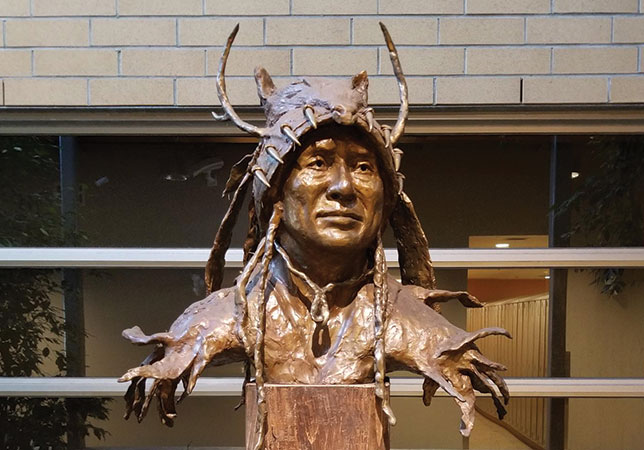
Year of installation: 2012
Institution: Université du Québec en Abitibi-Témiscamingue
Artists: Ernest Aness Dominique
One need only glance at Pavillon des Premiers-Peuples at Université du Québec en Abitibi-Témiscamingue (UQAT) in Val d’Or to understand the degree to which the institution prioritizes collaboration with Indigenous peoples. It would, however, be wrong to think this building, whose shape is inspired by a teepee, is the only Indigenous art on campus. On the contrary, UQAT is full of works created by Indigenous artists or honouring Indigenous cultures.
One such work is “Tshiashinnuat… L’Ancêtre,” created by Innu artist Ernest Aness Dominique. It depicts an ancestral chief of the Algonquian family, a brave hunter, warrior and nomad, in traditional clothing. To the artist, this sculpture of a chief gazing at a distant sunrise represents hope. The bronze bust symbolizes the close ties that have existed between UQAT and the First Peoples over the last four decades.
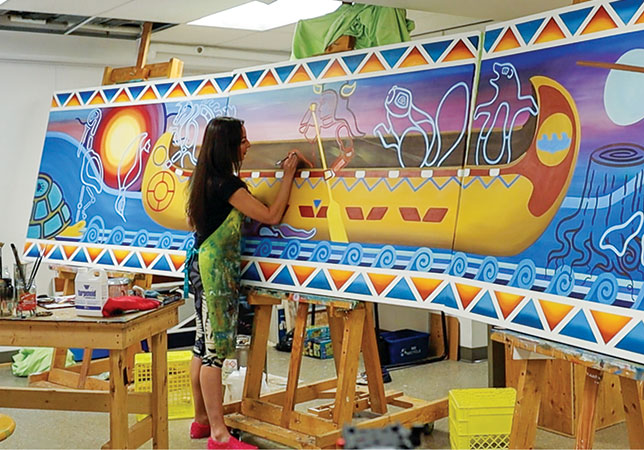
Year of installation: 2022
Institution: University of Manitoba
Artists: Kristin Flattery
A gym may seem like an odd place for a large, brightly coloured mural. But that is exactly where you can find Anishinaabe-Oyate artist Kristin Flattery’s work at the University of Manitoba. Located across from the customer service desk in the Active Living Centre, the mural is a visual re-telling of an Indigenous creation story passed down in Ininew (Cree), Anishinaabe and Oyate (Dakota) cultures through oral traditions. Ms. Flattery used vibrant colours and references to traditional sports such as lacrosse, re-imagining conflict as regenerative and placing relationships at the core of creation.
“We wanted to create something that inspired a movement in healthy living for everybody,” she explains. “So, not only was I trying to promote healthy living and insert our traditional knowledge… I want [the community] to be motivated toward teamwork and helping each other.”
The creation myth her mural draws on is about a great flood, like the biblical story of Noah’s Ark, she explains. But it differs greatly from the Christian story in that the world is constructed from a tiny piece of earth through the combined efforts of several different animals, foregrounding the importance of relationships in the process of creation.
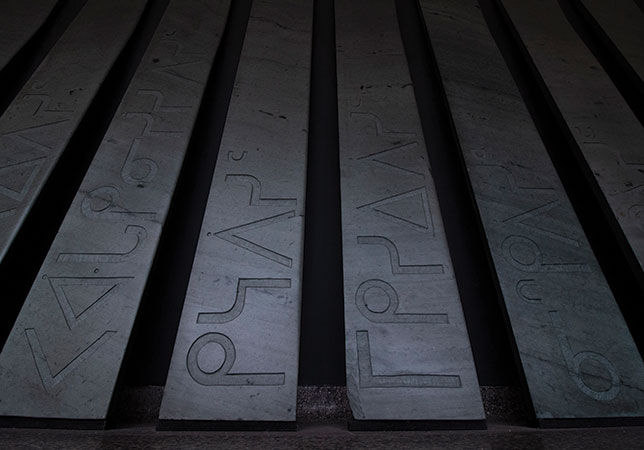
Year of installation: 2020-2021
Institution: University of Saskatchewan
Artists: Vanessa Hyggen, Sandy Bonny, Lyndon Tootoosis
The lunar cycle is an important guide to mark the passage of time in many Indigenous cultures. That was the inspiration for a set of stone carvings that now adorn the foyer of Gordon Snelgrove Gallery at the University of Saskatchewan. Thirteen slate stairs reclaimed from the century-old Thorvaldson Building were carved with Cree syllabics, denoting the traditional names of the 13 moons in the lunar calendar of Indigenous peoples.
The piece was the brainchild of three artists at the university: Vanessa Hyggen, executive assistant to the vice-dean, Indigenous; Sandy Bonny, team lead, Indigenous student achievement pathways and STEM access initiatives; and Lyndon Tootoosis, the 2020 Indigenous artist in residence. Discussions got underway back in 2019 but the pandemic delayed the work, says Ms. Hyggen, who is Norwegian and Cree, and a member of the Lac La Ronge Indian Band in Treaty 6 territory. Each carved step was unveiled on the day of the corresponding full moon, between October 2020 and September 2021. The response to the installation of the steps has been “really positive,” she says. “People are appreciative of the stories that they tell, and that they were part of campus for over 100 years.”
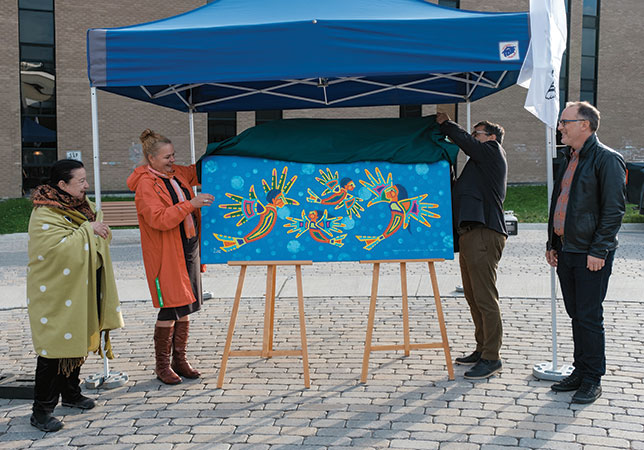
Année: 2021
Institut: Université de Sherbrooke
Artiste: Christine Sioui-Wawanoloath
On Sept. 30, 2021, the first National Day for Truth and Reconciliation, Université de Sherbrooke unveiled a painting which now adorns the faculty of education’s main hall. It was created by Abenaki-Wendat visual artist, storyteller and poet Christine Sioui-Wawanoloath, who titled the painting “De l’importance de bien apprendre à voler”. Marked by a bright and joyful colour palette, it depicts children spreading their wings under the watchful eye of adults, in a symbolic exploration of the theme of transmission.
“For us, there is no doubt that the path toward reparation with Indigenous peoples lies in education,” affirmed faculty of education dean Anne Lessard at the unveiling.
The painting is a permanent testament to the importance of relations with the First Peoples, and inspired the graphics of the university’s Action Plan for and With Indigenous Peoples, which was published in November 2021.
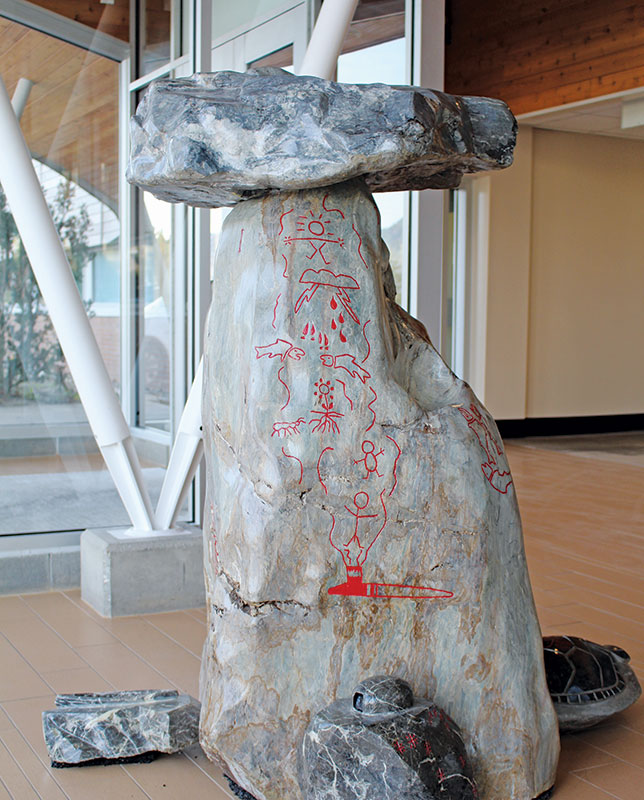
Year of installation: 2014
Institution: Thompson Rivers University
Artists: Rod Tomma, Ron Tomma and Mike Peters
The Kamloops campus of Thompson Rivers University is situated on the traditional and unceded territory of the Secwépemc people (which extends across much of the B.C. Interior). To commemorate that fact, in 2013 two graduates of the university’s law school proposed installing a land marker used by the Secwépemc to denote territorial boundaries or places of mythological significance. Three artists hailing from the Secwépemc Nation – Rod Tomma, Ron Tomma and Mike Peters – were commissioned and the fruits of their creative labour have been on display since 2014.
The marker stands inside one of the entrances to the Old Main building, which became the new home of the law faculty following a major renovation. It’s made from a rare type of quartz rock and is emblazoned with pictographs. Alan Shaver, who was TRU’s president and vice-chancellor when the marker was unveiled, said at the time that it would “inspire an appreciation of the land in which we live and learn in partnership with Aboriginal people.”
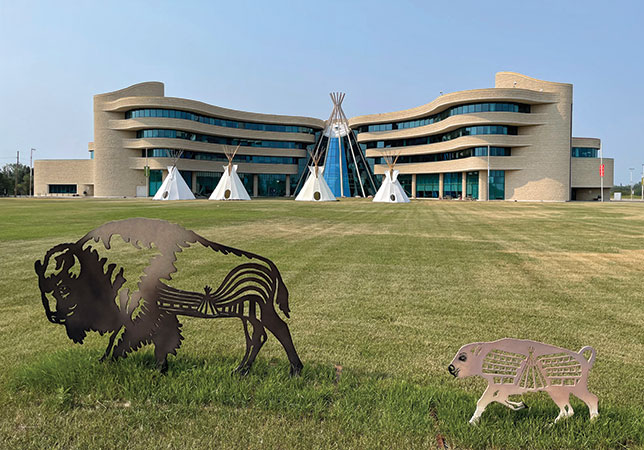
Year of installation: 2018-2019
Institution: First Nations University of Canada
Artist: Lionel Peyachew
Eight pairs of steel mother-and-calf buffalo stand on the lawn in front of the main building on the First Nations University of Canada’s campus in Regina. The sculptures are part of an effort by the institution to create a living art gallery with a focus on works by faculty and alumni, says Peter Brass, the university’s art collections manager. In this case, the pieces were created by Lionel Peyachew, a Cree artist from the Red Pheasant First Nation who is an associate professor of Indigenous fine art at FNUniv. Installed in 2018 and 2019, each buffalo features a carving of a teepee that corresponds with the towering glass structure that’s a defining part of the campus’ main building.
“Pre-contact, there were millions and millions of buffalo in North America. That was the main staple… Everything was made out of buffalo: your teepees, your implements, basically your clothing. It was sort of a survival thing to have buffalo around,” Mr. Peyachew says of the sculptures’ symbolism. “Today, the most important thing to Indigenous people is education.”
